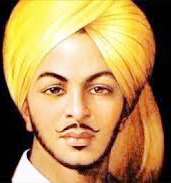Indian History
Shaheed Diwas
- 23 Mar 2021
- 5 min read
Why in News
Prime Minister of India paid tributes to Bhagat Singh, Sukhdev, Rajguru on Shaheed Diwas (23rd March).
- The Day is also known as Martyrs’ Day or Sarvodaya Day.
- This Day should not be confused with the Martyrs’ Day observed on 30th January, the day Mahatma Gandhi was assassinated.
Key Points
- About:
- Every year on 23rd March, Shaheed Diwas is observed.
- It was on this day that Bhagat Singh, Sukhdev and Rajguru were executed by the British government in 1931.
- They were hanged to death for assassinating John Saunders, a British police officer in 1928. They had mistook him for British police superintendent James Scott.
- It was Scott who had ordered lathi charge, which eventually led to the death of Lala Lajpat Rai.
- While Singh, who had publicly announced avenging Rai’s death, went into hiding for many months after this shootout, he resurfaced along with an associate Batukeshwar Dutt, and the two, in April 1929, set off two explosive devices inside the Central Legislative Assembly in Delhi.
- Allowed themselves to be arrested, while shouting the famous slogan: “Inquilab Zindabad“, or “Long live the revolution”.
- They were hanged to death for assassinating John Saunders, a British police officer in 1928. They had mistook him for British police superintendent James Scott.
- Their lives inspired countless youth and in their death, they set an example. They carved out their own path for independence, where individual heroism and their aggressive need to do something for the nation stood out, departing from the path followed by the Congress leaders then.
- Bhagat Singh:

- Born as Bhaganwala on the 26th September, 1907, Bhagat Singh grew up in a petty-bourgeois family of Sandhu Jats settled in the Jullundur Doab district of the Punjab.
- He belonged to a generation that was to intervene between two decisive phases of the Indian national movement - the phase of the 'Extremism' of Lal-Bal-Pal and the Gandhian phase of nonviolent mass action.
- In 1923, Bhagat Singh joined the National College, Lahore which was founded and managed by Lala Lajpat Rai and Bhai Parmanand.
- The College was set up as an alternative to the institutions run by the Government, bringing to the field of education the idea of Swadeshi.
- In 1924 in Kanpur, he became a member of the Hindustan Republican Association, started by Sachindranath Sanyal a year earlier. The main organiser of the Association was Chandra Shekhar Azad and Bhagat Singh became very close to him.
- It was as a member of the HRA that Bhagat Singh began to take seriously the philosophy of the Bomb.
- Armed revolution was understood to be the only weapon with which to fight British imperialism.
- In 1925, Bhagat Singh returned to Lahore and within the next year he and his colleagues started a militant youth organisation called the Naujawan Bharat Sabha.
- In April 1926, Bhagat Singh established contact with Sohan Singh Josh and through him the 'Workers and Peasants Party' which brought out the monthly magazine Kirti in Punjabi.
- For the next year Bhagat Singh worked with Josh and joined the editorial board of Kirti.
- In 1927, he was first arrested on charges of association with the Kakori Case, accused for an article written under the pseudonym Vidrohi (Rebel). He was also accused of being responsible for a bomb explosion at Lahore during the Dussehra fair.
- In 1928, Bhagat Singh changed the name of Hindustan Republican Association to Hindustan Socialist Republic Association (HSRA). In 1930, when Azad was shot, the HSRA collapsed.
- Naujawan Bharat Sabha replaced HSRA in Punjab.
- His time in the prison was spent protesting, seeking better living conditions for inmates. During this time, he gained the sympathy of the public, especially when he joined fellow defendant Jatin Das in a hunger strike.
- The strike ended with Das’ death from starvation in September 1929. Two years later, Singh was convicted and hanged at the age of 23.
- Born as Bhaganwala on the 26th September, 1907, Bhagat Singh grew up in a petty-bourgeois family of Sandhu Jats settled in the Jullundur Doab district of the Punjab.




